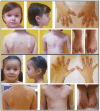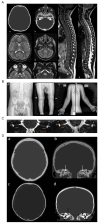Early Diagnosis and Follow-Up of a Novel Homozygous Mutation in SOST Gene in a Child with Recurrent Facial Palsy: A Case Report and Review of the Literature
- PMID: 40943101
- PMCID: PMC12427825
- DOI: 10.3390/ijms26178175
Early Diagnosis and Follow-Up of a Novel Homozygous Mutation in SOST Gene in a Child with Recurrent Facial Palsy: A Case Report and Review of the Literature
Abstract
Recurrent facial palsy is a rare event in the pediatric population, mostly idiopathic or associated with common comorbidities or, rarely, observed in syndromic conditions. However, some cases are difficult to explain and need more accurate diagnostic approaches. In this work, we describe a pediatric case of recurrent facial palsy secondary to hyperostosis of the skull and narrowing of the neural foramina related to a SOST-related sclerosing bone dysplasia. To our knowledge, this is the first Italian case that is also related to a novel loss-of-function variant in the SOST gene. We highlight the clinical relevance of a proper early diagnosis and the need for correct monitoring of the clinical evolution, considering the natural history of the disease, to prevent/reduce severe neurological complications.
Keywords: SOST; SOST-related sclerosing bone dysplasia; recurrent facial palsy.
Conflict of interest statement
Authors Eloisa Evangelista and Luigia De Falco were employed by the company AMES, Centro Polidiagnostico Strumentale, srl. The remaining authors declare that the research was conducted in the absence of any commercial or financial relationships that could be construed as a potential conflict of interest.
Figures



References
-
- Appelman-Dijkstra N., Van Lierop A., Papapoulos S. SOST-Related Sclerosing Bone Dysplasias. In: Adam M.P., Feldman J., Mirzaa G.M., Pagon R.A., Wallace S.E., Amemiya A., editors. GeneReviews®. University of Washington; Seattle, WA, USA: 1993. - PubMed
Publication types
MeSH terms
Substances
LinkOut - more resources
Full Text Sources

